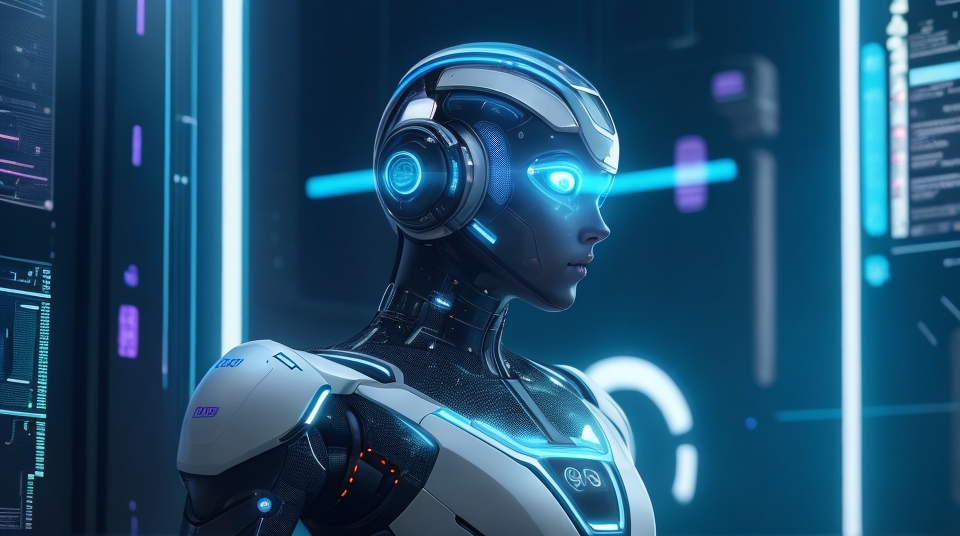AI for Improving Content Accessibility
AI, or artificial intelligence, has become an increasingly powerful and influential force in today's world. From self-driving cars to virtual assistants, AI technology is revolutionizing various industries and changing the way we live and work. But one area where AI has shown immense promise is in improving accessibility for individuals with disabilities. In this article, we will explore the role of AI in accessibility, the current state of accessibility, the potential of AI in this field, and examine some real-life case studies that demonstrate the effectiveness of AI in making content more accessible.
The Role of AI in Accessibility
Accessibility refers to the design of products, devices, services, or environments that aim to enable people with disabilities to function independently and effectively. It is about removing barriers and giving everyone equal access to information and resources. AI plays a crucial role in accessibility by providing innovative solutions that enhance the way people with disabilities interact with the world.
The Current State of Accessibility
Although significant progress has been made in improving accessibility, there are still numerous challenges to overcome. Many websites, applications, and digital content often fail to meet the needs of individuals with disabilities, making it difficult for them to access and understand the information they need. This lack of accessibility hinders their participation in various aspects of life, including education, employment, and social interactions.
The Potential of AI for Accessibility
AI holds enormous potential for improving accessibility because of its ability to analyze data, recognize patterns, and make intelligent decisions. By leveraging AI technology, it is possible to develop solutions that can transform the way people with disabilities interact with content. From speech transcription and captioning to content readers and translation services, AI offers a range of tools that can bridge the accessibility gap and empower individuals with disabilities.
Case Studies of AI in Accessibility
To better understand the impact and effectiveness of AI in accessibility, let's delve into some real-life case studies. These examples highlight how AI is being used to make content more accessible for individuals with disabilities.
AI Solutions for Accessibility
There are several AI solutions available today that are specifically designed to enhance accessibility. Let's explore some of these solutions and how they contribute to making content more accessible.
Speech Transcription and Captioning
Speech transcription and captioning technologies leverage AI algorithms to convert spoken words into written text. These solutions are particularly essential for individuals with hearing impairments as they enable them to read and understand conversations, videos, and other audio content. By automatically transcribing and captioning speech, AI helps bridge the communication gap and ensures that individuals with hearing impairments can access information in real-time.
Content Readers and Translation Services
AI-powered content readers and translation services are instrumental in improving the accessibility of written content. These tools utilize natural language processing and machine learning algorithms to convert text into human-like speech, making it easier for individuals with visual impairments to access and understand written information. By providing audio versions of written content, AI enables individuals with visual impairments to engage with text-based information effortlessly. Additionally, AI translation services make it possible to convert content into different languages, further enhancing accessibility for individuals who are not proficient in a specific language.
Voice Assistants
Voice assistants, such as Amazon's Alexa, Apple's Siri, and Google Assistant, are widely used AI technologies that have a significant impact on accessibility. These assistants enable individuals with motor disabilities or limited mobility to interact with technology using voice commands rather than relying on traditional input methods like keyboards or touchscreens. Voice assistants can perform various tasks, such as searching the web, playing music, creating reminders, and controlling smart home devices, making technology more accessible and inclusive for everyone.
Facial Recognition and Computer Vision
AI-powered facial recognition and computer vision technologies are revolutionizing accessibility for individuals with visual impairments. These solutions enable people to navigate their surroundings independently by detecting and identifying objects, faces, and text in real-time. By using a mobile device or wearable technology equipped with AI features, individuals with visual impairments can receive real-time audio descriptions of their surroundings, helping them move around safely and confidently. Additionally, AI computer vision technology can also help individuals with cognitive disabilities by automatically recognizing and providing context for objects and situations.
AI's Impact on People with Visual and Speech Impairments
Visual and speech impairments are two common disabilities that significantly impact an individual's ability to access and interact with content. Let's explore how AI is improving accessibility for individuals with these disabilities.
Text-to-Speech Technologies
For individuals with visual impairments, reading written text can be a daunting task. However, AI-powered text-to-speech technologies are changing the game. These solutions utilize natural language processing and machine learning algorithms to convert written text into spoken words. By providing audio versions of written content, text-to-speech technologies enable individuals with visual impairments to access and understand information in a more accessible format.
Object Recognition Technologies
AI object recognition technologies are empowering individuals with visual impairments by enabling them to navigate and interact with their environment more effectively. By using a combination of cameras, machine learning algorithms, and computer vision techniques, these solutions can detect and recognize objects, faces, and text. This information is then relayed to the user through audio descriptions, allowing them to interact with their surroundings confidently and independently. From identifying the contents of a can of food to reading street signs, AI object recognition technologies have tremendous potential in enhancing the accessibility and independence of individuals with visual impairments.
The Impact on the Lives of People with Impairments
AI technologies designed to improve accessibility have a profound impact on the lives of individuals with disabilities. By providing them with tools and capabilities that were previously unavailable or limited, AI empowers individuals with disabilities to participate fully in society. Accessible content ensures that individuals with impairments can access educational resources, employment opportunities, and participate in social interactions on an equal footing.
Future Potential of AI in this Area
The potential of AI in improving accessibility for individuals with visual and speech impairments is vast. As AI technology continues to advance, we can expect to see even more powerful and innovative solutions that address the unique challenges faced by individuals with disabilities. From improved text-to-speech technologies to enhanced object recognition capabilities, the future of AI in this field looks promising.

AI as a Force Multiplier in Accessibility
The Concept of AI as a Force Multiplier
In the realm of accessibility, AI serves as a force multiplier by amplifying the abilities of individuals with disabilities. By leveraging AI technology, individuals can accomplish tasks that were previously challenging or impossible, thereby breaking down barriers and promoting inclusivity. AI acts as a catalyst, enabling individuals with disabilities to overcome the limitations imposed by their impairments and participate in activities that were once inaccessible.
How AI Unlocks Solutions for Accessibility Challenges
AI unlocks solutions for accessibility challenges by providing innovative tools and technologies that enable individuals with disabilities to overcome barriers. Whether it's through speech transcription and captioning, content readers, voice assistants, or object recognition, AI offers a range of solutions that enhance accessibility. These technologies leverage AI's ability to process large volumes of data, recognize patterns, and make intelligent decisions, resulting in more accessible content and environments.
AI's Role in Assisting People with Disabilities
AI plays a crucial role in assisting people with disabilities by providing them with tools and capabilities that enhance their independence and access to information. By augmenting their existing abilities, AI enables individuals with disabilities to interact with the world on their terms. Whether it's through voice assistants that enable individuals with limited mobility to control their environment or object recognition technologies that provide audio descriptions of the environment, AI enhances accessibility and empowers individuals with disabilities to lead fulfilling and independent lives.
Making Workplaces and Everyday Life More Inclusive with AI
AI has the potential to make workplaces and everyday life more inclusive for individuals with disabilities. By ensuring that digital content is accessible and providing tools that aid in communication and navigation, AI technology can break down barriers and promote inclusivity. From accessible websites and applications to AI-powered workplace accommodations, AI offers a range of solutions that facilitate equal access and enable individuals with disabilities to contribute fully to society.
The Future of AI in Accessibility
The Potential of AI for Future Accessibility Solutions
As technology continues to advance, the potential of AI for future accessibility solutions is immense. With ongoing research and development, we can expect to see even more innovative and effective AI technologies that address the unique challenges faced by individuals with disabilities. From personalized AI assistants that cater to specific accessibility needs to advanced object recognition and navigation systems, the future of AI in accessibility holds great promise.
Challenges and Limitations of AI in Accessibility
While AI offers significant potential for improving accessibility, there are still challenges and limitations that need to be addressed. One of the primary challenges is ensuring that AI technologies are developed with inclusivity in mind. AI algorithms need to be trained on diverse datasets that represent the full spectrum of human abilities and experiences to avoid bias and exclusion. Additionally, privacy concerns and ethical considerations surrounding the use of AI in accessibility must also be carefully addressed to ensure the rights and wellbeing of individuals with disabilities.
The Role of Companies and Organizations in AI Accessibility
Companies and organizations play a crucial role in driving the development and adoption of AI accessibility solutions. By prioritizing accessibility in their products, services, and content, these entities can create a more inclusive and accessible digital landscape. Additionally, collaborations between AI researchers, disability advocates, and technology companies can lead to the development of innovative solutions that address the unique accessibility challenges faced by individuals with disabilities.
Case Studies of Future AI Accessibility Projects
Looking ahead, it is evident that AI will continue to have a profound impact on accessibility. Let's examine some hypothetical case studies of future AI accessibility projects to gain insights into how AI can further enhance accessibility.
-
AI-Powered Virtual Reality (VR) for Assistive Learning: Imagine a future where AI-powered virtual reality systems provide individuals with disabilities immersive learning experiences tailored to their needs. By combining AI algorithms, natural language processing, and gesture recognition, AI-powered VR can create inclusive educational environments where individuals with disabilities can interact, learn, and explore without physical limitations.
-
AI-Enhanced Prosthetics: Prosthetic limbs with AI-enhanced capabilities have the potential to revolutionize accessibility for individuals with limb impairments. With AI algorithms that can understand and respond to the user's intent, these prosthetics can provide more natural and intuitive movement, giving individuals a higher degree of control and functionality.
-
AI-Driven Smart Homes: AI technology can transform homes into more accessible and inclusive environments. By integrating AI-powered systems that recognize and respond to the specific accessibility needs of the occupants, individuals with disabilities can have greater control over their living spaces, from adjusting lighting and temperature to controlling appliances and security systems.
In conclusion, AI is a powerful tool for improving content accessibility for individuals with disabilities. It offers a range of innovative solutions, from speech transcription and captioning to object recognition and navigation, that enhance accessibility and promote inclusivity. As technology continues to advance, the future of AI in accessibility holds great promise, and organizations and companies have a vital role to play in driving the development and adoption of AI accessibility solutions. By embracing AI technology and prioritizing accessibility, we can move closer to a more inclusive and accessible world for everyone.

AI Tools for Accessibility
Overview of AI Tools for Accessibility
AI tools for accessibility encompass a wide range of technologies and applications that leverage artificial intelligence to enhance accessibility for individuals with disabilities. These tools utilize AI algorithms to analyze, interpret, and transform content and environments so that they can be accessed and understood by diverse users. By harnessing the power of AI, these tools are able to bridge the accessibility gap and empower individuals with disabilities to access information, engage with technology, and navigate their surroundings more effectively.
Automatic Captioning Tools
Automatic captioning tools are AI-powered solutions that generate captions for audio and video content in real-time. These tools utilize speech recognition algorithms to transcribe spoken words into written text, which can then be displayed as captions on screen. Automatic captioning tools are particularly useful for individuals with hearing impairments as they provide a visual representation of the spoken content, enabling them to understand and engage with audio-visual content more effectively. By automatically generating captions, these AI tools make audio and video content more accessible for all users.
AI-Powered Overlays
AI-powered overlays are tools that enhance the accessibility of websites and applications by providing customizable user interfaces and alternative modes of interaction. These overlays utilize AI algorithms to analyze the structure and content of web pages and dynamically modify them to meet the specific accessibility needs of individuals. For example, overlays can adjust the size and color contrast of text, provide alternative navigation options, or convert content into different formats, such as braille or audio. AI-powered overlays make it possible for individuals with disabilities to personalize their online experiences and access information in a way that suits their specific needs.
Automated Scanners
Automated scanners are AI tools that assess the accessibility of digital content, applications, and websites by analyzing their structural elements and identifying potential accessibility barriers. These scanners utilize AI algorithms to detect and report accessibility issues, such as missing alternative text for images, improper heading structures, or color contrast violations. By automating the scanning process, these tools make it easier for developers and content creators to identify and rectify accessibility issues, ensuring that their digital content is accessible to individuals with disabilities.
The Impact of AI on Web Accessibility
Understanding Web Accessibility
Web accessibility refers to the practice of designing and developing websites and web-based applications that can be accessed and used by individuals with disabilities. It involves ensuring that individuals with visual, auditory, cognitive, or motor impairments can perceive, navigate, and interact with web content effectively. Web accessibility is crucial for promoting inclusivity and ensuring equal access to information and services in the digital age.
The Role of AI in Enhancing Web Accessibility
AI plays a significant role in enhancing web accessibility by providing tools and technologies that address the specific challenges faced by individuals with disabilities. AI-powered solutions, such as automatic captioning tools, AI-powered overlays, and automated scanners, enable individuals with disabilities to access and interact with web content more effectively. These tools ensure that websites and applications are compatible with assistive technologies, provide alternative modes of interaction, and identify and resolve accessibility barriers.
The Limitations of AI in Web Accessibility
While AI offers significant potential in improving web accessibility, it is not without limitations. AI algorithms rely on training data to learn and make intelligent decisions. If the training data is biased or limited, it can result in AI solutions that are not fully inclusive or effective in addressing accessibility challenges. Additionally, AI tools may not always be able to accurately interpret complex content, such as images or multimedia, which may require human intervention for proper accessibility implementation.
Future Prospects of AI in Web Accessibility
The future prospects of AI in web accessibility are promising. Ongoing research and development are aimed at improving the accuracy and effectiveness of AI solutions in addressing accessibility challenges. Advanced AI algorithms, coupled with better training data and increased awareness of accessibility requirements, will likely lead to more inclusive and accessible web experiences for individuals with disabilities. Furthermore, the integration of AI with emerging technologies, such as augmented reality and virtual reality, has the potential to create immersive and accessible web experiences that cater to a wide range of accessibility needs.
AI in Education for Improved Accessibility
The Need for Accessibility in Education
Accessibility in education is crucial for ensuring equal opportunities and quality education for all students, including those with disabilities. The traditional education system often presents barriers that prevent individuals with disabilities from fully participating in educational activities and accessing educational resources. AI tools can play a transformative role in addressing these barriers and improving accessibility in education.
Role of AI Tools in Education
AI tools in education offer a range of possibilities for improving accessibility. For individuals with visual impairments, AI-powered assistive technologies, such as text-to-speech readers or object recognition software, can enable access to educational content and materials. For students with learning disabilities, AI-based adaptive learning platforms can provide personalized and targeted instruction to address individual needs. Additionally, AI tools can assist educators in developing inclusive instructional materials and assessing student progress.
Case Studies: AI Tools for Educators
Several AI tools have been developed to support educators in making educational content and resources more accessible. For example, there are AI-powered plagiarism checkers that assist educators in identifying potential cases of plagiarism in student work. AI-powered grading systems can help automate and streamline the grading process, saving educators time and effort. AI chatbots can also be used to provide personalized support and assistance to students, answering questions and addressing their individual concerns.
Future of AI in Accessible Education
Looking ahead, the future of AI in accessible education holds immense potential. As AI technology continues to evolve, we can expect to see even more advanced and tailored solutions for individuals with disabilities. From AI-powered virtual tutors that adapt to individual learning styles to AI-driven learning management systems that provide personalized recommendations, the integration of AI in education has the power to transform the learning experience and make education more inclusive for all students.

AI and Content Accessibility
Understanding Content Accessibility
Content accessibility refers to the design and adaptation of digital content, such as articles, documents, videos, or websites, to ensure that individuals with disabilities can access and understand the information they contain. Content accessibility involves factors such as providing alternative text for images, utilizing proper headings and structure, ensuring proper color contrast, and providing captions or transcripts for audio and video content. AI technologies can greatly enhance content accessibility through various methods.
AI for Content Generation and Analysis
AI can be utilized to generate accessible content by automatically adapting it to meet specific accessibility guidelines. For instance, AI algorithms can generate alternative text descriptions for images based on their visual content, providing individuals with visual impairments a better understanding of the visual content. AI-powered tools can also analyze written content and provide suggestions for improvements to address readability and comprehension for different audiences, including individuals with cognitive disabilities.
AI for Content Enrichment and Personalization
AI can be employed to enrich content and make it more engaging and accessible. Natural language processing and sentiment analysis techniques can be used to analyze written content and tailor it to the specific needs and preferences of individuals. AI-powered tools can adapt the presentation format of the content, such as adjusting font size, color contrast, or text-to-speech synthesis, based on the individual's preferences and accessibility requirements. This customization ensures that the content is accessible and engaging for a diverse range of users.
Challenges and Solutions in AI-Powered Content Accessibility
While AI offers significant potential in enhancing content accessibility, there are challenges that need to be addressed. One challenge is ensuring that AI algorithms are trained on diverse and representative datasets to avoid bias and exclusion. Furthermore, the accuracy and effectiveness of AI-powered content accessibility tools need to be continuously improved to ensure that they can reliably meet the needs of individuals with disabilities. Regular testing, user feedback, and collaboration with disability experts are crucial to address these challenges and ensure that AI-powered solutions deliver on their promise of improved content accessibility.
Ethical Considerations in AI for Accessibility
Understanding the Ethical Implications of AI
As AI becomes more prevalent in improving accessibility, it is essential to consider the ethical implications of its use. Ethical considerations in AI accessibility include issues such as privacy, data security, bias, and fairness in the development and deployment of AI-powered accessibility tools. It is crucial to ensure that AI is used in a responsible and inclusive manner, without infringing on the rights and dignity of individuals with disabilities.
Managing Bias in AI for Accessibility
Bias in AI algorithms can inadvertently perpetuate or exacerbate existing biases and discriminatory practices. To ensure fairness and inclusivity, it is crucial to actively manage and mitigate bias in AI-powered accessibility solutions. This involves diverse and representative training data, ongoing monitoring, and evaluation of AI algorithms to identify and address potential biases, and involving individuals with disabilities in the development and testing process.
Prioritizing Accessible Code in AI Development
Developers and AI researchers have a responsibility to prioritize accessibility in the code and architecture of AI-powered tools. By incorporating accessibility best practices into the design and development process, AI solutions can be more accessible by default. This includes ensuring that user interfaces are compatible with assistive technologies, adhering to accessibility standards and guidelines, and considering the specific needs and preferences of individuals with disabilities in the design process.
Customization of AI Solutions for Accessibility
It is essential to recognize that accessibility needs vary greatly among individuals with disabilities. Customization of AI solutions plays a crucial role in meeting these diverse needs. AI-powered accessibility tools should allow for flexibility and customization, enabling individuals to personalize their experiences according to their specific requirements. By providing adjustable settings, preferences, and options, AI tools can empower individuals with disabilities to tailor their experiences and access information in a way that best suits their unique needs.
In conclusion, AI has immense potential in improving accessibility across various domains, including web accessibility, education, content accessibility, and more. Through the development and integration of AI tools specifically designed for accessibility, we can enhance inclusivity and empower individuals with disabilities to access and engage with content, technology, and their environment more effectively. However, it is crucial to address the limitations, ethical considerations, and challenges associated with AI for accessibility to ensure that its use is not only effective but also responsible, inclusive, and respectful of the rights and needs of individuals with disabilities.

Authority Websites: Boosting Credibility and Trust
AI automation agency services play a critical role in building and maintaining authority websites. These services utilize AI-powered algorithms to analyze search trends, user behavior, and industry insights. By leveraging this data, businesses can create content that addresses the specific needs and interests of their target audience.
With AI automation agency services, businesses can optimize their authority websites in various ways. These services can ensure that meta tags are optimized for relevant keywords, improving the website's visibility in search engine results. They can also analyze overall website structure, ensuring user-friendly navigation that enhances the browsing experience.
Additionally, AI automation agency services can help businesses create keyword-rich, relevant content. By utilizing AI-powered algorithms, these services can recommend topics and keywords that are highly searched, ensuring that the provided information matches user intent. The result is a website that establishes the brand as a trusted source of information, boosting credibility and trust among visitors.
Social Media Posts: Enhancing Engagement and Brand Awareness
Social media has become a powerful tool for businesses to connect with their target audience. AI automation agency services simplify social media management by automating tasks such as content scheduling, post optimization, and performance tracking.
These services leverage AI algorithms to analyze user behavior and preferences, enabling businesses to deliver timely, relevant, and engaging content to their social media followers. AI automation agency services can recommend optimal posting times, allowing businesses to capitalize on peak engagement periods. They can also provide insights into the best content formats for specific platforms, ensuring that businesses maintain a consistent brand presence across social media channels.
Furthermore, AI automation agency services can assist in analyzing the performance of social media posts. By tracking metrics such as reach, engagement, and click-through rates, businesses can gain valuable insights into the effectiveness of their social media strategies. This data-driven approach enables businesses to make informed decisions and optimize future content to maximize audience engagement and brand awareness.
Feature Images: Captivating Visual Storytelling
Visual content plays a pivotal role in capturing audience attention and conveying brand messaging effectively. AI automation agency services assist businesses in creating captivating feature images that align with their brand aesthetics and messaging.
These services leverage AI-powered image recognition algorithms to analyze colors, shapes, and patterns. By doing so, they can generate visually stunning images that resonate with the target audience and enhance the overall user experience. Additionally, AI automation agency services can automatically resize and optimize images for various platforms, ensuring that they load quickly and display optimally across devices.
By utilizing AI automation agency services for feature image creation, businesses can enhance their visual storytelling. Compelling imagery can help businesses make a lasting impression, increase engagement, and effectively communicate their core values and offerings.
AI-Driven Apps: Enhancing User Experience
Mobile apps are essential for businesses looking to provide a seamless and personalized user experience. AI automation agency services can develop AI-driven apps that leverage machine learning algorithms to understand user behavior, preferences, and patterns.
These AI-driven apps excel in personalization by providing tailored recommendations, predictive search results, and intelligent chatbots. By analyzing vast amounts of user data, such as past interactions and preferences, these apps can continuously learn and evolve to deliver a tailored user experience that meets the unique needs of each individual.
Additionally, AI automation agency services can assist businesses in optimizing app load times, ensuring a smooth and responsive experience. By leveraging AI algorithms, these services can analyze performance metrics and make recommendations for optimizing app performance, resulting in improved user satisfaction and increased engagement.
In conclusion, AI automation agency services offer numerous benefits across various aspects of content management. From building authority websites that establish credibility and trust to managing social media posts for enhanced engagement, these services streamline content creation and distribution processes. Additionally, they can create captivating feature images and develop AI-driven apps that enhance the user experience. By embracing AI automation agency services, businesses can optimize their content strategies, increase brand awareness, and achieve marketing success in the evolving digital landscape.

FAQs about AI for Improving Content Accessibility
What is AI's role in improving content accessibility?
AI plays a crucial role in improving content accessibility by providing innovative solutions that enhance the way people with disabilities interact with information and resources. Through AI-powered tools such as speech transcription, content readers, and object recognition technologies, individuals with disabilities can access and understand content in a way that suits their specific needs.
How does AI enhance web accessibility?
AI enhances web accessibility by providing tools and technologies that address the challenges faced by individuals with disabilities when accessing web content. AI-powered overlays can customize user interfaces, while automated scanners can identify and rectify accessibility issues. These AI tools ensure that websites are compatible with assistive technologies and provide alternative modes of interaction.
What are some popular AI tools for improving content accessibility?
Some popular AI tools for improving content accessibility include automatic captioning tools, AI-powered overlays, and automated scanners. Automatic captioning tools generate captions for audio and video content, while overlays modify web interfaces to meet specific accessibility needs. Automated scanners analyze content for accessibility issues, helping developers identify and rectify any barriers.
How can AI improve accessibility in education?
AI tools in education can improve accessibility by providing assistive technologies for individuals with disabilities. Text-to-speech readers, object recognition software, and adaptive learning platforms are some examples of AI tools that can aid students with visual impairments, learning disabilities, or other accessibility needs. These tools enable personalized learning experiences and foster inclusivity in educational settings.
What ethical considerations are important in the use of AI for accessibility?
Ethical considerations in the use of AI for accessibility include managing bias, prioritizing accessible code, and customization of AI solutions. It is crucial to ensure that AI algorithms are trained on diverse and representative datasets to avoid bias and discrimination. Developers should prioritize accessibility in the code and design of AI solutions and provide customization options to meet diverse accessibility needs.


